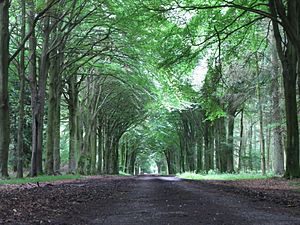Grovely Wood facts for kids
Grovely Wood is one of the largest woodlands in southern Wiltshire, England. It sits on a chalk ridge above the River Wylye in Barford St Martin parish. It's located southwest of the village of Great Wishford and is part of the beautiful Cranborne Chase and West Wiltshire Downs area, which is known for its natural beauty. A walking path called The Sarum Way goes through the wood.
Grovely Wood is very important for nature. It's officially recognized as a County Wildlife Site, which means it's a special place for plants and animals. One of the cool creatures you might find here is the rare Purple Emperor butterfly.
To the west of Grovely, on the same ridge, you'll find another big forest called Great Ridge Wood. Right next to Grovely, to the north, is a grassy area called Ebsbury Down, which is also a special protected site for nature. Another nearby nature spot is Baverstock Juniper Bank.
Contents
A Look into Grovely Wood's Past
Grovely Wood has a long and interesting history, with many signs of ancient people.
Ancient Settlements and Roads
You can find lots of evidence from the Iron Age and Roman times around the woods. The Iron Age was a period in history when people started using iron tools, and the Roman period was when the Roman Empire ruled parts of Britain.
A Roman road runs right through the middle of Grovely Wood from east to west. At the western end, there are old settlements from the Iron Age and Roman times, like Hanging Langford Camp and Church End Ring. These were places where people lived long ago.
Just north of the woods, there are two hillforts from the Iron Age. Hillforts were large, fortified settlements built on hills, often for protection. These are called Ebsbury and Grovely Castle. There's also an Iron Age farm area known as East Castle.
Old Boundaries of the Forest
Hundreds of years ago, in the 1200s, Grovely Forest was much bigger. It stretched north and east to the River Wylye and south to the River Nadder. On its western side, it reached the villages of Wylye and Teffont Evias.
By the 1800s, the boundaries had changed, and most of the woodland became part of the Barford parish.
Special Traditions at Grovely Wood
Grovely Wood is also famous for a very old tradition that still happens today.
The Ancient Wood-Gathering Custom
People from the village of Great Wishford have a special right to collect firewood in Grovely Wood. This tradition happens every year on Oak Apple Day, which is May 29th.
This custom is very old, possibly going back to the Middle Ages (a long time ago!). It was officially confirmed in 1603 by a special court for the forest. This means the villagers have a historic right, like a special permission, to gather wood from the Royal Forest of Groveley.
Mysterious Stories of Grovely Wood
Like many old woodlands, Grovely Wood has its own spooky and interesting folklore.
The Handsel Sisters' Tale
There's a sad story about four sisters called the Handsel sisters. They were from Denmark but lived near Wilton. In 1737, a terrible illness called smallpox spread and many people died. Some local people wrongly believed the sisters were responsible and accused them of being witches.
Without a proper trial, the sisters were taken to Grovely Wood, where they were killed and buried separately. People say this was done so they couldn't "conspire" even after death. Today, there are four old, twisted beech trees linked to the sisters. Some say the trees were planted to mark their graves, while others believe they mysteriously grew on top of the unmarked graves as a reminder of what happened.
Over the years, people have reported seeing the sisters' ghosts. There's a hollow space at the back of the largest tree where people sometimes leave small gifts or offerings. These trees are about 50 meters from the Roman road, a short walk from the Wilton end of the wood.
The Burcombe Woodsman
Another story is about the Burcombe Woodsman. Some say he was a poacher (someone who hunts illegally) who was hanged from a tree for his crimes. Others believe he was an artist who painted with watercolors and was accidentally shot during a deer hunt in the woods. He was said to have stayed in Burcombe, which is how he got his name. People have reported seeing him, often after hearing the sound of a twig snapping nearby.
An old carving on Purbeck marble found in 1857 might show Alan de Langford, who was a "Verderer" of Grovely Wood in the late 1200s. A Verderer was an officer who looked after the royal forests and made sure forest laws were followed. The carving shows a man in a long robe with a horn hanging from his shoulder.
Grovely Wood During World War II
Grovely Wood played a role during the Second World War.
The Royal Air Force (RAF) had a storage area for weapons and supplies called an ordnance depot at Chilmark, west of the wood. Parts of Grovely Wood were used to hide these supplies. Until about 1951, trains brought supplies to nearby stations like Wylye and Wishford. The United States Air Force also used this area for the same purpose.


